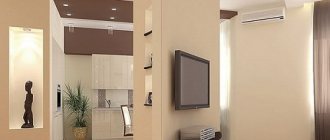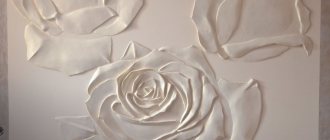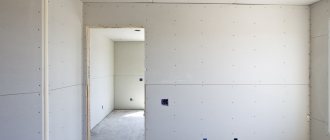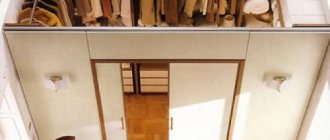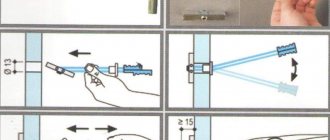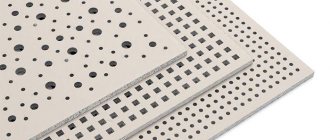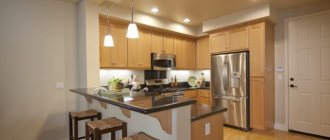In this article we will tell you how to make a plasterboard partition with a door with your own hands. Such a partition made of plasterboard sheets is erected very quickly and with almost no debris. It has sufficient strength and good sound insulation. And when finishing gypsum plasterboard, the wall is very simple, because it turns out perfectly flat. This is ideal if the work is performed by a person with no experience.
Another undeniable advantage of a plasterboard partition is that dragging sheets and metal profiles to the upper floors does not cause problems, because they have a variety of sizes and are light in weight. Here is an incomplete list of gypsum board sizes: 3000*1200, 2500*1200, 2000*1200, 1500*1200, 1500*600. Metal profiles come in lengths of 3 and 4 m, they are very light.
Leveling walls by gluing gypsum boards
The frameless method of attaching gypsum boards seems simple. But to get a high-quality result, you need to do quite a lot of work. Gluing is carried out according to the following scheme:
- Complete removal of old finishes. It is especially important to remove adhesives previously used for tiles or wallpaper.
- Degreasing the surface to eliminate the presence of areas to which drywall will not stick.
- Priming the walls to ensure good adhesion of the adhesive composition on the drywall to the cleaned wall.
- Direct gluing of gypsum boards should be carried out taking into account the characteristics of the wall to which they will be attached.
If differences along the wall are no more than 5 mm, gypsum putty is applied around the perimeter of the sheet using a notched trowel. Also, two long strips of adhesive are applied at a distance of 40 cm from the edges.
If the difference is from 5 mm to 2 cm, you need to use thicker plasterboard adhesive. It is applied with a regular spatula in the form of small piles around the perimeter and inside the perimeter at a distance of 10-15 cm from each other.
With differences of 2 to 4 cm, strips or squares of plasterboard - beacons - are initially glued to the wall. They are glued to gypsum putty, creating a non-standard frame. In this case, the joints of the sheets should be in the center of the lighthouse. Only after the putty has dried (this may take 2-3 days) are the sheets glued. The adhesive composition is pre-applied to the beacons.
Methods for finishing gypsum board walls
The original clean finish of drywall will help give the room a stylish look. Acceptable options for cladding walls from gypsum plasterboard include:
- painting: for painting you can use conventional compounds or paints with a craquelure effect, pieces of fabric, glitter;
- wallpapering: an affordable and simple finishing method;
- coating with decorative plaster: non-standard compositions will help quickly transform a room;
- tiling: the optimal solution for the bathroom, but it is worth remembering that plasterboard walls are not able to withstand heavy loads, so it is better to place the tiles at the bottom and combine them with other types of finishes;
- finishing with plastic lining: installing the lining is easy and simple, in addition, it will help to reliably protect the drywall itself from moisture and mechanical damage;
- wooden lining or board: an unsuitable option due to the significant weight of the materials, however, such elements can be used to stylize (divide or decorate) walls.
Types of profiles for drywall: sizes, selection and scope of application
Special fittings are used for gypsum boards: reinforced guides and rack-mount metal profiles. Guides are used to attach the frame frame to the ceiling or floor. They are divided into four types depending on the cross-section: from 5x4 cm to 10x4 cm.
The length of guide profiles of any thickness is 300 cm.
The vertical parts of the partition frame are also made from the profile. Such fittings are also divided into four types by cross-section: minimum 5x5 cm, maximum 10x5 cm. The length of the rack profile is 300–400 cm.
Partition thickness control
If you have a question about which profile to choose for a false wall, given that this choice will determine its thickness, it will not be difficult to solve it. Measure the thickness of the interior walls in your apartment. It will be approximately 10 cm. Use this value as a guide.
Moreover, you will be surprised to discover that it is precisely this PS brand profile that is recommended to be used for creating interior walls.
The PS profile is available in three sizes relative to the cross section - 50x50, 75x50 and 100x50 mm. The last one is the most common. A feature of the PS profile, among other things, is the presence along the entire length of mounting holes designed to facilitate wiring inside the profile cavity of utilities.
The simplest DIY design looks like this: a sheet of gypsum board – a profile – a sheet of plasterboard. Insulation - optional
But pay attention to the other two sizes. If the structure is only decorative in nature, if it will not experience a significant load, a PS profile with a section size of 50x50 and 75x50 mm may be perfect.
It is also necessary to keep in mind that there are 3 more types of metal aluminum profiles on the construction market:
- PP profile (CD) is the main type, but for suspended ceilings. It has a cross section of 60x25 mm. Of course, PP is mainly for ceilings, but you can also use it for false walls. This desire will be facilitated by one unique modification of the PP profile - arched, convex or concave, allowing you to create unique curved structures. This profile is produced without mounting holes.
- PN (UD) is “not an independent profile”, since according to the designers’ idea it is intended as an auxiliary guide for the PP profile. But where does the design thought of an inquisitive worker not lead? The PN profile can be successfully used as a completely independent element, this is facilitated by its small cross-section - 28x27 mm.
- PN (UW) – as a type of profile used as PS guides.
Helpful advice! Each master decides independently which profile to choose to create a partition, focusing on the purpose of the false wall. If there is insulation, use a PS profile 100 mm wide. Only this will allow glass wool to be placed inside without undue stress on the entire structure.
How to cut drywall
The profile for a plasterboard partition can be cut with metal scissors, but the plasterboard itself can be cut with a sharp knife, after first marking the sheet. The cardboard is first cut through one side of the plasterboard sheet, then the material is laid on the edge of the table and bent to break the gypsum core.
The next step is to turn the drywall over and cut the outer layer on the other side. When covering interior partitions based on a metal frame, it is better to first use solid sheets, installing them in the center.
